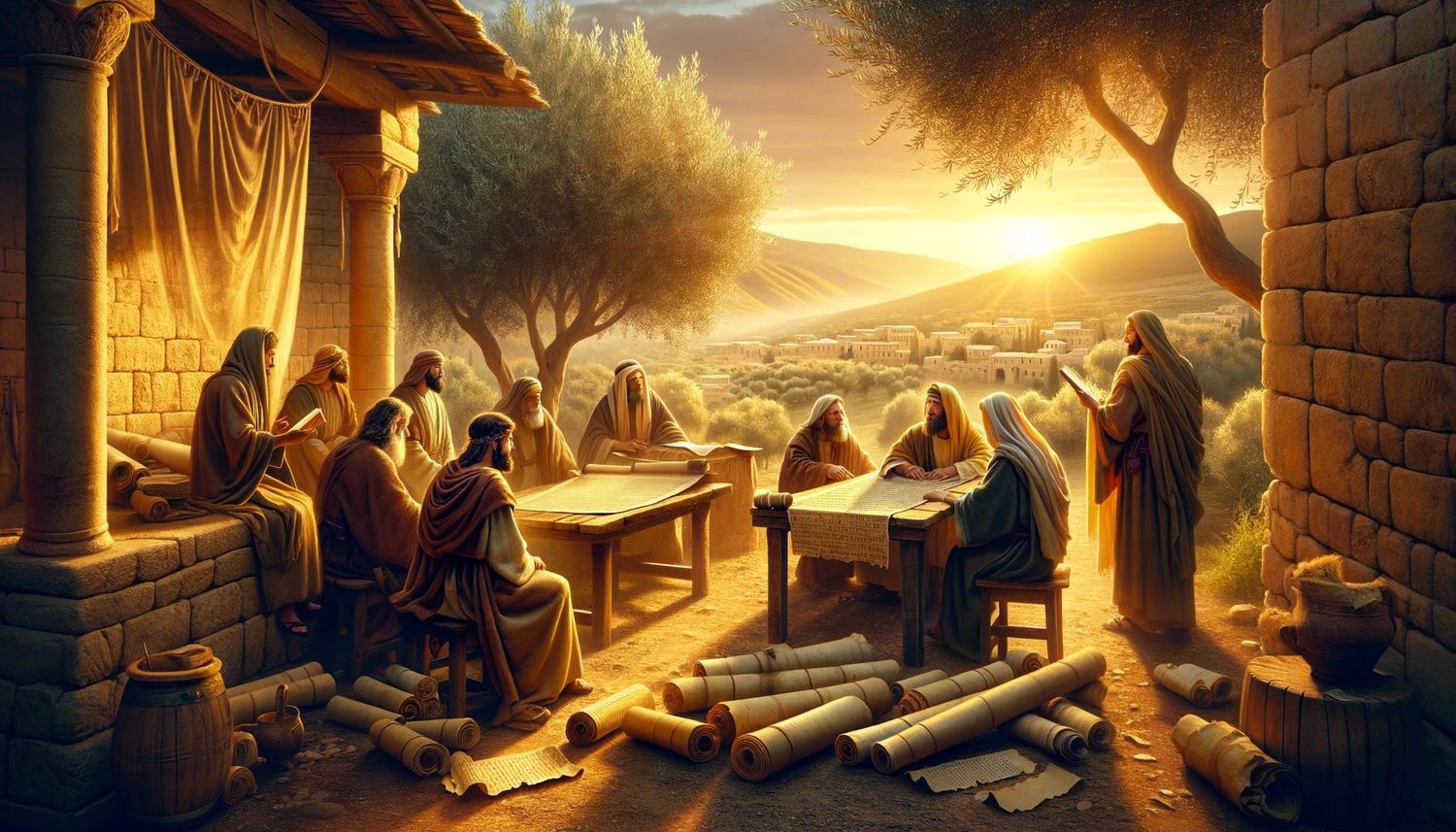Home>Christian Videos>Bible Stories>Who Chose The Gospels


Bible Stories
Who Chose The Gospels
Published: March 6, 2024
Ericka Andersen, an editor at Christian.net, expertly merges digital strategy with content creation, focusing on faith and societal issues. Her communication skills enhance the platform's engaging narratives, fostering meaningful dialogue on belief's impact on society.
Discover the fascinating history behind the selection of the Gospels and their significance in the Bible. Explore the intriguing stories that have shaped the foundation of Christianity.
(Many of the links in this article redirect to a specific reviewed product. Your purchase of these products through affiliate links helps to generate commission for Christian.net, at no extra cost. Learn more)
Table of Contents
Introduction
Who chose the Gospels? This question delves into the origins of the New Testament and the process by which the four Gospels of Matthew, Mark, Luke, and John were selected to be included in the Bible. The selection of these texts was a complex and multifaceted process that involved the input of early Christian communities, the influence of church leaders, and the impact of historical events. Understanding the formation of the New Testament canon sheds light on the development of Christian beliefs and practices. Let's explore the intricate journey of how the Gospels came to be recognized as authoritative and sacred texts in the Christian tradition.
Read more: Who Is Jesus In The Gospels
The Formation of the New Testament Canon
The formation of the New Testament canon was a gradual process that took place over several centuries. It involved the careful selection and recognition of certain texts as authoritative and inspired by early Christian communities. The canonization of the New Testament was not a singular event but rather a complex and dynamic development that unfolded over time. The early Christian communities played a pivotal role in this process, as they sought to preserve and transmit the teachings and accounts of Jesus Christ and the apostles. The formation of the New Testament canon was influenced by a variety of factors, including theological considerations, the need for standardization of beliefs, and the desire to distinguish authentic Christian writings from other contemporary texts.
The process of canonization was not uniform across all Christian communities, and different regions had varying collections of texts that were considered authoritative. However, over time, certain writings gained widespread acceptance and recognition as essential to the Christian faith. The criteria for inclusion in the New Testament canon were not explicitly defined early on, leading to debates and discussions within the early Christian communities. As the need for a standardized collection of authoritative texts became more apparent, church leaders and theologians began to deliberate and establish criteria for determining which writings should be included in the New Testament.
The formation of the New Testament canon was also influenced by the emergence of heresies and divergent theological perspectives within the early Christian movement. In response to these challenges, church leaders and councils sought to clarify and affirm the core beliefs of Christianity by identifying and endorsing specific texts as the authoritative sources of Christian doctrine. The process of canonization involved careful consideration of the theological coherence, apostolic authorship, and widespread usage of the texts, among other factors.
The recognition of the four Gospels of Matthew, Mark, Luke, and John as central to the New Testament canon was a significant milestone in the formation of the Christian scriptures. These texts were valued for their portrayal of the life, teachings, death, and resurrection of Jesus Christ, and they became foundational to the Christian faith. The formation of the New Testament canon reflects the collective discernment and affirmation of early Christian communities, church leaders, and theologians regarding the essential texts that would shape the beliefs and practices of Christianity for centuries to come.
The Role of Early Christian Communities
The early Christian communities played a crucial role in the formation of the New Testament canon. These communities were comprised of individuals who were deeply committed to preserving and transmitting the teachings and accounts of Jesus Christ and the apostles. As the Christian movement began to spread and diversify, different regions and congregations possessed varying collections of texts that were considered authoritative. This diversity of perspectives and writings within the early Christian communities contributed to a rich tapestry of beliefs and practices. However, it also led to debates and discussions about which texts should be recognized as essential to the Christian faith.
The early Christian communities were instrumental in the preservation and dissemination of the oral traditions and written accounts of Jesus' life, teachings, and ministry. These communities cherished the firsthand testimonies of those who had encountered Jesus and sought to safeguard the authenticity of the teachings attributed to him. As the need for a standardized collection of authoritative texts became more apparent, the early Christian communities engaged in dialogue and discernment to identify the most reliable and spiritually edifying writings.
The diverse and dynamic nature of the early Christian communities meant that different regions had distinct preferences for certain texts, leading to variations in the collections of writings that were considered sacred and authoritative. However, amidst this diversity, certain writings gained widespread acceptance and recognition as essential to the Christian faith. The early Christian communities' reverence for these texts and their commitment to preserving the apostolic traditions contributed to the eventual recognition of the core texts that would form the New Testament canon.
The early Christian communities' role in the formation of the New Testament canon underscores the organic and communal nature of the process. Their collective discernment, preservation of sacred texts, and commitment to the apostolic traditions were foundational to the eventual recognition of the Gospels and other writings as authoritative and inspired. The influence of these communities in shaping the New Testament canon highlights the significance of communal discernment and the transmission of beliefs and practices within the early Christian movement.
The Influence of Church Leaders
Church leaders played a significant role in the formation of the New Testament canon. As the early Christian movement expanded and encountered theological diversity, the guidance and influence of church leaders became crucial in discerning the authoritative texts that would shape Christian beliefs and practices. The recognition of certain writings as inspired and essential to the faith required the endorsement and affirmation of influential figures within the Christian community. Church leaders, including bishops, theologians, and influential figures such as Ignatius of Antioch and Irenaeus of Lyons, contributed to the process of canonization by advocating for specific texts and articulating the theological rationale for their inclusion in the New Testament.
The influence of church leaders in the formation of the New Testament canon was evident in their efforts to address theological controversies and heresies that emerged within the early Christian movement. As divergent perspectives and conflicting interpretations of Christian teachings arose, church leaders sought to clarify and affirm the core beliefs of Christianity. They played a pivotal role in identifying and endorsing certain texts as authoritative sources of Christian doctrine, thereby shaping the theological landscape of the emerging Christian tradition.
The recognition of the four Gospels as central to the New Testament canon was significantly influenced by the advocacy and support of church leaders who recognized the theological significance and spiritual value of these texts. The writings of influential figures such as Origen and Athanasius provided critical insights into the criteria for determining the authenticity and authority of the Gospels, contributing to their widespread acceptance within the Christian community. Church leaders' discernment and advocacy for specific texts reflected their commitment to preserving the apostolic traditions and ensuring the coherence and integrity of Christian beliefs.
The influence of church leaders in the formation of the New Testament canon highlights the communal and deliberative nature of the process. Their theological insights, pastoral guidance, and advocacy for specific texts contributed to the eventual recognition of the Gospels and other writings as authoritative and inspired. The collective discernment and endorsement of church leaders played a crucial role in shaping the New Testament canon and establishing the foundational texts that would guide the beliefs and practices of Christianity for centuries to come.
The Criteria for Inclusion in the New Testament
The criteria for inclusion in the New Testament were carefully deliberated and established by early Christian communities and church leaders to discern which writings should be recognized as authoritative and inspired. Several key criteria were considered in the process of canonization, reflecting the theological, historical, and communal dimensions of the texts that would form the New Testament.
-
Apostolic Authorship or Association: One of the primary criteria for inclusion in the New Testament canon was the apostolic authorship or association of the texts. Early Christian communities and church leaders sought to preserve the teachings and accounts directly linked to the apostles or individuals closely associated with them. This criterion aimed to ensure the authenticity and reliability of the writings, emphasizing their direct connection to the foundational figures of the Christian faith.
-
Theological Coherence and Consistency: The theological coherence and consistency of the texts were essential considerations in the process of canonization. Church leaders and theologians evaluated the writings based on their alignment with the core beliefs and teachings of Christianity, emphasizing the harmony of the texts with the broader Christian tradition. The theological coherence of the writings was crucial in affirming their value as authoritative sources of Christian doctrine.
-
Widespread Usage and Acceptance: The widespread usage and acceptance of the texts within the early Christian communities played a significant role in their recognition as essential to the Christian faith. The enduring impact and spiritual edification provided by certain writings contributed to their widespread circulation and reception among diverse Christian congregations. The recognition of the Gospels and other writings as authoritative was influenced by their enduring relevance and resonance within the Christian community.
-
Doctrinal and Spiritual Edification: The doctrinal and spiritual edification offered by the texts were important factors in their inclusion in the New Testament canon. Church leaders and theologians considered the capacity of the writings to nurture the faith and spiritual growth of believers, emphasizing their enduring value as sources of guidance, inspiration, and theological insight. The writings that were recognized for their doctrinal and spiritual significance were esteemed for their formative impact on the beliefs and practices of the Christian community.
-
Orthodox Content and Avoidance of Heresy: The adherence to orthodox Christian teachings and the avoidance of heretical content were critical criteria in the process of canonization. Church leaders and theologians scrutinized the texts to ensure their alignment with the core tenets of the Christian faith, guarding against the propagation of heretical doctrines or misleading interpretations. The commitment to preserving the integrity and purity of Christian beliefs guided the discernment of the writings included in the New Testament.
The criteria for inclusion in the New Testament reflect the collective discernment and affirmation of early Christian communities and church leaders regarding the essential texts that would shape the beliefs and practices of Christianity. These criteria underscore the theological, historical, and communal dimensions of the canonization process, emphasizing the careful consideration of the apostolic traditions, theological coherence, spiritual impact, and doctrinal fidelity of the writings that comprise the New Testament.
Read more: Who Was Mark In The Gospels
The Impact of Historical Events
The formation of the New Testament canon was significantly influenced by historical events that shaped the development of early Christianity and the broader cultural and political landscape of the ancient world. The impact of historical events on the recognition and acceptance of certain writings as authoritative and inspired was profound, reflecting the dynamic interplay between the Christian movement and the historical context in which it emerged.
-
Persecution and Martyrdom: The experience of persecution and martyrdom within the early Christian communities had a profound impact on the formation of the New Testament canon. The writings that conveyed the steadfast faith and courage of martyrs, such as the accounts of the apostles and early Christian leaders, gained heightened significance and spiritual resonance within the Christian community. The enduring witness of these individuals in the face of persecution contributed to the recognition of certain texts as sources of inspiration and spiritual fortitude, shaping the collective identity and beliefs of early Christians.
-
The Roman Empire and Christian Expansion: The expansion of Christianity within the Roman Empire and beyond influenced the recognition of certain writings as essential to the faith. As the Christian movement spread to diverse regions and encountered varying cultural contexts, the need for a standardized collection of authoritative texts became increasingly apparent. The impact of the Roman Empire's cultural and political influence on the dissemination and reception of Christian writings contributed to the eventual recognition of the Gospels and other texts as foundational to the Christian tradition.
-
The Councils and Synods: The convening of councils and synods within the early Christian community played a pivotal role in shaping the New Testament canon. The deliberations and decisions made at events such as the Council of Nicaea and the Council of Carthage contributed to the affirmation and recognition of certain writings as authoritative and inspired. The impact of these historical gatherings on the establishment of the New Testament canon underscored the communal discernment and affirmation of essential texts that would guide the beliefs and practices of Christianity.
-
The Preservation of Apostolic Traditions: The preservation of apostolic traditions and teachings in the face of historical challenges and theological controversies influenced the recognition of certain writings as essential to the Christian faith. The enduring commitment of early Christian communities to safeguarding the apostolic heritage and transmitting the teachings of Jesus and the apostles contributed to the recognition of the Gospels and other texts as authoritative sources of Christian doctrine.
-
The Codification of Christian Beliefs: The codification of Christian beliefs and the articulation of theological doctrines within the early Christian movement influenced the recognition of certain writings as foundational to the faith. The impact of historical events on the formulation of creeds, statements of faith, and theological treatises contributed to the discernment and affirmation of specific texts as essential to the Christian tradition.
The impact of historical events on the formation of the New Testament canon reflects the dynamic interplay between the Christian movement and the broader historical, cultural, and political context in which it emerged. The enduring witness of martyrs, the expansion of Christianity, the convening of councils, the preservation of apostolic traditions, and the codification of Christian beliefs all contributed to the recognition and acceptance of certain writings as authoritative and inspired, shaping the development of the Christian scriptures.
Conclusion
The formation of the New Testament canon was a complex and multifaceted process that involved the input of early Christian communities, the influence of church leaders, and the impact of historical events. The recognition of the four Gospels of Matthew, Mark, Luke, and John as central to the New Testament canon was a significant milestone in the development of the Christian scriptures. The criteria for inclusion in the New Testament, including apostolic authorship, theological coherence, widespread usage, doctrinal and spiritual edification, and avoidance of heresy, reflected the collective discernment and affirmation of essential texts that would shape the beliefs and practices of Christianity. The impact of historical events, such as persecution and martyrdom, the expansion of Christianity, the convening of councils, the preservation of apostolic traditions, and the codification of Christian beliefs, influenced the recognition and acceptance of certain writings as authoritative and inspired. The formation of the New Testament canon underscores the communal and deliberative nature of the process, highlighting the organic development of Christian beliefs and the enduring significance of the Gospels and other texts as foundational to the Christian tradition.














